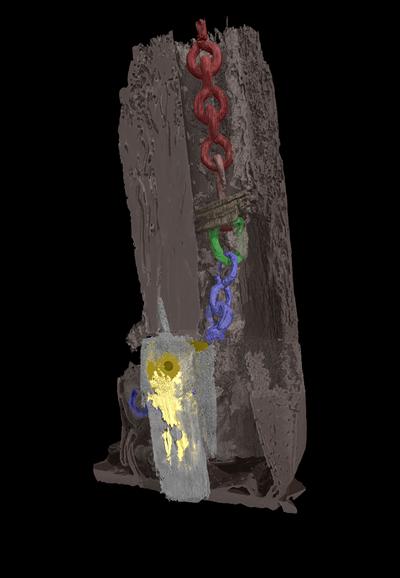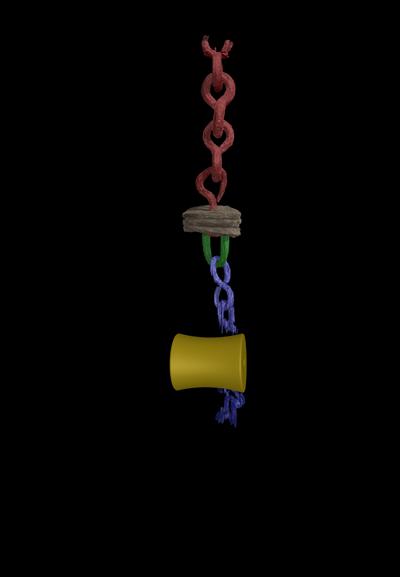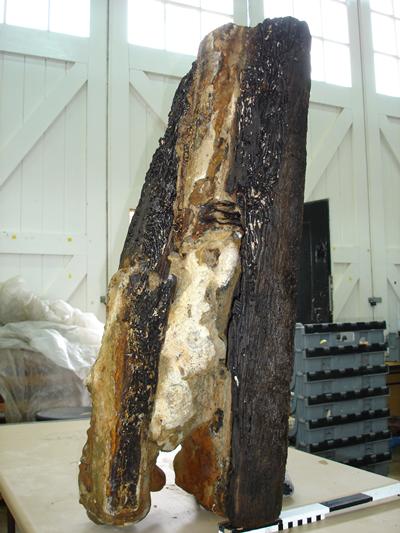Chain pump from 17th century warship deconstructed using latest x-ray technology

Academics from the University of Southampton are working with the archaeological charity Seadive to ‘virtually’ examine the mechanism of a chain pump from a 17th century warship.
The project, led by Archaeology alumni Daniel Pascoe and funded by English Heritage, has used the high-energy micro-focus CT scanner at the University’s µ-VIS Centre for Computed Tomography to peer inside the entombed remains of the pump. It was recovered by Seadive Director of Operations Robert Peacock, who is licensee of the protected wreck of Northumberland (1679) which sank on the Goodwin Sands off the coast of Kent.
University of Southampton Engineer Dr Mark Mavrogordato says: “The section of pump we have examined is physically very large and dense – a challenge in terms of x-ray penetration. Thanks to our 450kV micro-focus source and highly sensitive detector array, we have been able to do this successfully and reveal the individual working parts of the pump without physically altering it.”
The Northumberland is one of 47 wreck sites in England protected under the Protection of Wrecks Act 1973. English Heritage Maritime Designation Advisor, Mark Dunkley says: “English Heritage funded the work because archaeological evidence of ship pumps from the 17th century is extremely rare. This work presented a unique opportunity for us to better understand how ships would have functioned at sea without having to dismantle the pump itself. English Heritage will now commence the process of conserving this important artefact at our laboratory in Portsmouth, prior to it going on public display in Ramsgate.”
The chain pump was used to remove water from the bilge of the warship, raising it up to and discharging it out through the scuppers on the gun deck – then into the sea. Chain pumps were fundamental for safety, as all ships leaked and without operational pumps they could be in severe danger of sinking. Northumberland’s pump consisted of a pump tube made of oak, which ran vertically up through the ship from the bilge. A chain on a continuous loop, with leather valves located every 30 inches passed through this tube, drawing the water upwards.
Seadive archaeologist and project leader Daniel Pascoe, who completed his degree in Archaeology in 2002 and then his Masters in Maritime Archaeology in 2007, explains: “The Northumberland’s chain and valves are entombed in concretion – a hard deposit made up of sand, shell and corosion products from the iron chain. This encasement makes it impossible to identify, by conventional means, the construction, size and shape of the individual working parts of the pump.”
Daniel continues: “Chain pumps are generally quite well documented, but historical information lacks detail on the shape and size of their component parts. However, the CT scanning at Southampton has given us precise measurements for Northumberland’s chain pump mechanism – a first for this type of pump.
“The scans clearly show the chain is S-shaped, with the eyes at 90 degrees. The valve is made up of three leather discs situated on top of a swivel that attaches to the chain. Crucially, the scanning has provided us with a level of detail where a reconstruction could be made.”
The equipment at the University of Southampton’s µ-VIS Centre for Computed Tomography works in a similar way to a medical CAT scanner, but is more powerful and capable of much greater resolutions. The high-energy micro-focus scanner rotates samples through 360 degrees, taking thousands of 2D images, which are then used to build a detailed 3D virtual representation of the original object. This can then be viewed from all angles and positions inside the object.
Northumberland was a 70 gun ‘third rate’ warship launched in 1679 as one of the thirty ‘great ships’ of Samuel Pepys shipbuilding programme. Northumberland took part in some of the most major and infamous battles of the late 17th century, including the defeat by the French at Beachy Head in 1690, victory at Barfleur/ La Hogue in 1692 and the second bombardment on St Malo in 1695. She was then rebuilt at Chatham and was back at sea by 1702 for the Battle of Vigo Bay. Tragically, she wrecked with all hands on the Goodwin Sands, famously known as the ‘ship swallower’ during the Great Storm of November 26th 1703.
In 2008 with a surface recovery licence, the charity Seadive recovered a section of the Northumberland’s chain pump from the seabed. The wood of its exposed surface was being attacked by marine boring organisms and recovery was essential to ensure its survival. After conservation, the chain pump will go on display at Ramsgate Maritime Museum, hopefully accompanied by the recently produced visual imagining from the CT scanning at Southampton.

